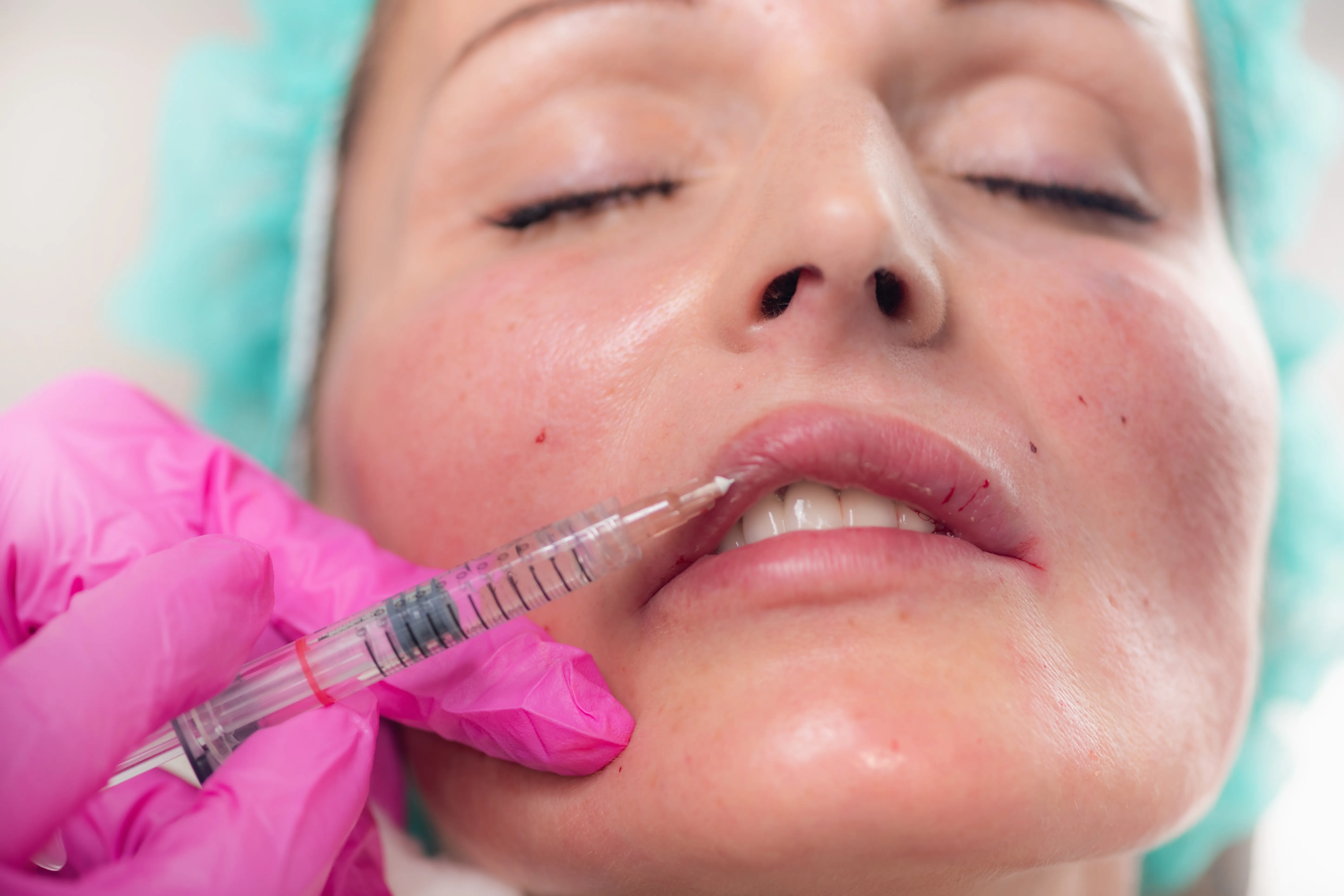Lip filler migration is a serious concern among those considering dermal lip fillers, as it occurs when filler migrates from its original injection site into other areas of lips or face, usually manifesting visually as lumps, puffy upper lips, lack of defined edge between lip edge and below (think duck lips) as well as lumps arising within them (known as microangiomas).
Poor injection technique is most often the culprit of migrating filler, while other potential sources may include:
Poor Injection Techniques
Injection techniques play a pivotal role in whether lip filler migration occurs. To minimize its chances, make sure an experienced injector performs your treatment; less-than-professional injectors could put too much product in one session, or not space out sessions enough so it integrates with natural tissue properly. Furthermore, popular techniques like Russian lips can cause filler to migrate more readily due to forcing tissues to expand too rapidly, making it easier for products like Botox(r) to spread away from its intended injection site.
Lip filler migration may occur if the filler chosen doesn’t work well with your skin. Each filler type requires different skin elasticity for proper adhesion; some choices, like hyaluronic acid, tend to migrate more than others such as calcium hydroxyapatite or poly-L-lactic acid; hyaluronic acid is usually preferred because its results can be reversed using an enzyme solution called hyaluronidase if necessary.
Migration may also result from aesthetic providers’ attempts to correct issues caused by filler that has moved by adding more filler in its place – this often isn’t a long-term solution and may only lead to additional complications later. Dr Tim of Aesthetics Mastery Show says some clinicians believe adding extra lip filler will correct migration’s beak-like appearance; this rarely works and typically makes matters worse; Dr Tim suggests finding the ideal provider that can assist you with building the support structures for lips that enhance their look while appearing more natural than before – Dr Tim suggests finding someone who can assist you with building this support structure so as not relying solely on fillers for beak-like appearance caused by migration.
Not Following Aftercare Instructions
Lip filler migration is a serious risk that could derail your dreams of fuller lips, yet when scrolling through TikTok hashtag #fillermigration it will quickly become clear how rarely this issue actually arises – most people never experience filler migration at all! But if this issue concerns you there are plenty of measures you can take to reduce its likelihood.
Lip filler migration usually results from improper application, including incorrect placement or over injection. Lips can only accommodate so much filler at one time; when too much is injected in one area it becomes unmanageable and must be managed accordingly to prevent swelling and potential complications. It’s vital that practitioners provide aftercare instructions; otherwise this may increase swelling risk and cause more complications down the line.
Filler migration could also be due to it not breaking down naturally enough; depending on its composition, this process may take anywhere between six months and one year for complete metabolism of all filler material in your system. You can speed this process along by massaging affected areas with hot compresses.
Fillers may also be dissolving with an enzyme known as Hyaluronidase, which will breakdown hyaluronic acid to promote natural metabolic process within your body and allow you to naturally dispose of it over time. However, for optimal results when opting to have lip fillers removed by this method it’s essential that experienced injectors perform this service.
Lip filler migration is an extremely rare occurrence and should not dissuade you from seeking treatment. Provided you see an experienced practitioner and follow all aftercare guidelines, you should be fine. Just remember, it is always better to err on the side of caution! If lip filler fillering intrigues you, book an appointment or consultation today with an experienced practitioner from Youth Haus Estheticians; our highly-trained estheticians are ready to help you achieve the look of your dreams! Get in touch now!
Poorly Placed Filler
One of the key causes of lip filler migration is an untrained injector. This could be due to an absence of knowledge, training or simply not understanding how to inject correctly; as aesthetic treatments are generally unregulated this can allow people to practice without appropriate qualifications or certifications.
If your filler has moved from its original place, don’t be alarmed – it is harmless yet not ideal aesthetically. First make sure it is actual lip filler migration rather than another side effect such as swelling, bruising or redness; your injector should be able to confirm this for you before dissolving it using an enzyme called Hyaluronidase which breaks down hyaluronic acid gel fillers for more natural looking results.
Filler may migrate if it was injected in the wrong plane. A thin plane separates orbicularis oris muscle and lips skin, and when filler injection occurs in this region it can easily move. Too-deep injections can also result in filler leaving its intended spot.
To avoid this from occurring, it’s essential that you select a qualified practitioner with experience who understands how to achieve natural-looking results. At your consultation session, take note of how they work with lips and ask them about their approach; this will ensure you can feel secure knowing your treatment will be in safe hands.
Too much lip filler injection may also cause migration; this could be caused by either an inexperienced injector or patient wanting fuller lips. When this happens, lips may appear puffy or enlarged around the cutaneous border and philtrum creating an “beak-like” appearance that requires correction to appear normally again.
Solution to lip filler migration issues are straightforward – ask your injector to dissolve the filler with hyaluronidase, and re-inject in more natural-looking ways – this should give a far more natural-looking outcome while eliminating any future problems with filler migration.
Poorly Placed Needle
Lip filler migration might appear to be a common occurrence on social media (TikTok has over 36 million views for #fillermigration hashtag), but in reality it’s actually rare. Understanding how it occurs will enable you to better avoid it in future.
Lip filler migration occurs when dermal filler moves away from its intended injection site and past the “vermillion border,” the line that divides lips from gums. Displaced dermal filler can distort facial features unnaturally and create unattractive distortions no one wants!
Poor injection technique or selecting an inappropriate filler are among the many factors that could lead to lip migration. To minimize risk, ensure you’re being treated by an experienced provider who specializes in lip filler treatments; additionally it’s also important to remember the viscosity and density of your injectable can have an effect. Hyaluronic acid-based products like Juvederm or Restylane products should only ever be injected into lips; other types of fillers, like collagen-containing or biostimulatory fillers aren’t suitable as they may lead to migration if injected there.
While your practitioner should possess all of the experience and expertise required, you can help prevent lip filler migration by following all postcare instructions carefully. This will minimize swelling, decrease infection risks and ensure your body can heal effectively after treatment.
Understanding your lips’ anatomy is also key in having an informed conversation with your provider about the desired result from lip fillers. An inexperienced provider could overfill them, leading to migration over time.
Avoiding complications stemming from injectable filler is all about being aware of what to watch for and being able to recognize when something goes amiss. As long as you conduct sufficient research and select a provider with extensive expertise, migrating filler should only occur rarely with proper injections done correctly.
Disclaimer: The content on this blog is intended for general informational purposes only. It is not a substitute for professional medical advice, diagnosis, or treatment. Always consult qualified healthcare providers for personalized advice. Information regarding plastic surgery, dental treatment, hair transplant, and other medical procedures is educational and not a guarantee of results. We do not assume liability for actions taken based on blog content. Medical knowledge evolves; verify information and consult professionals. External links do not imply endorsement. By using this blog, you agree to these terms.





